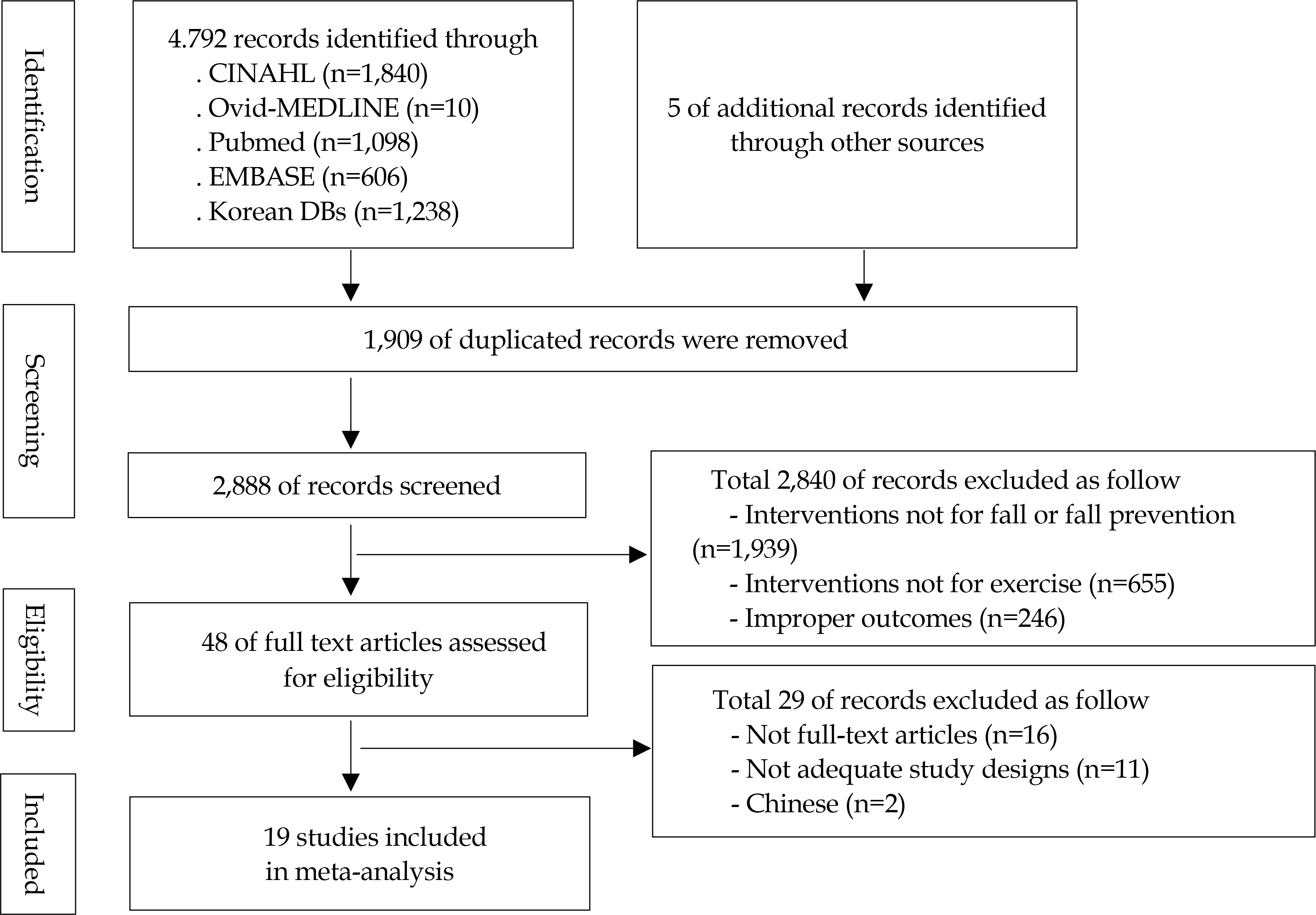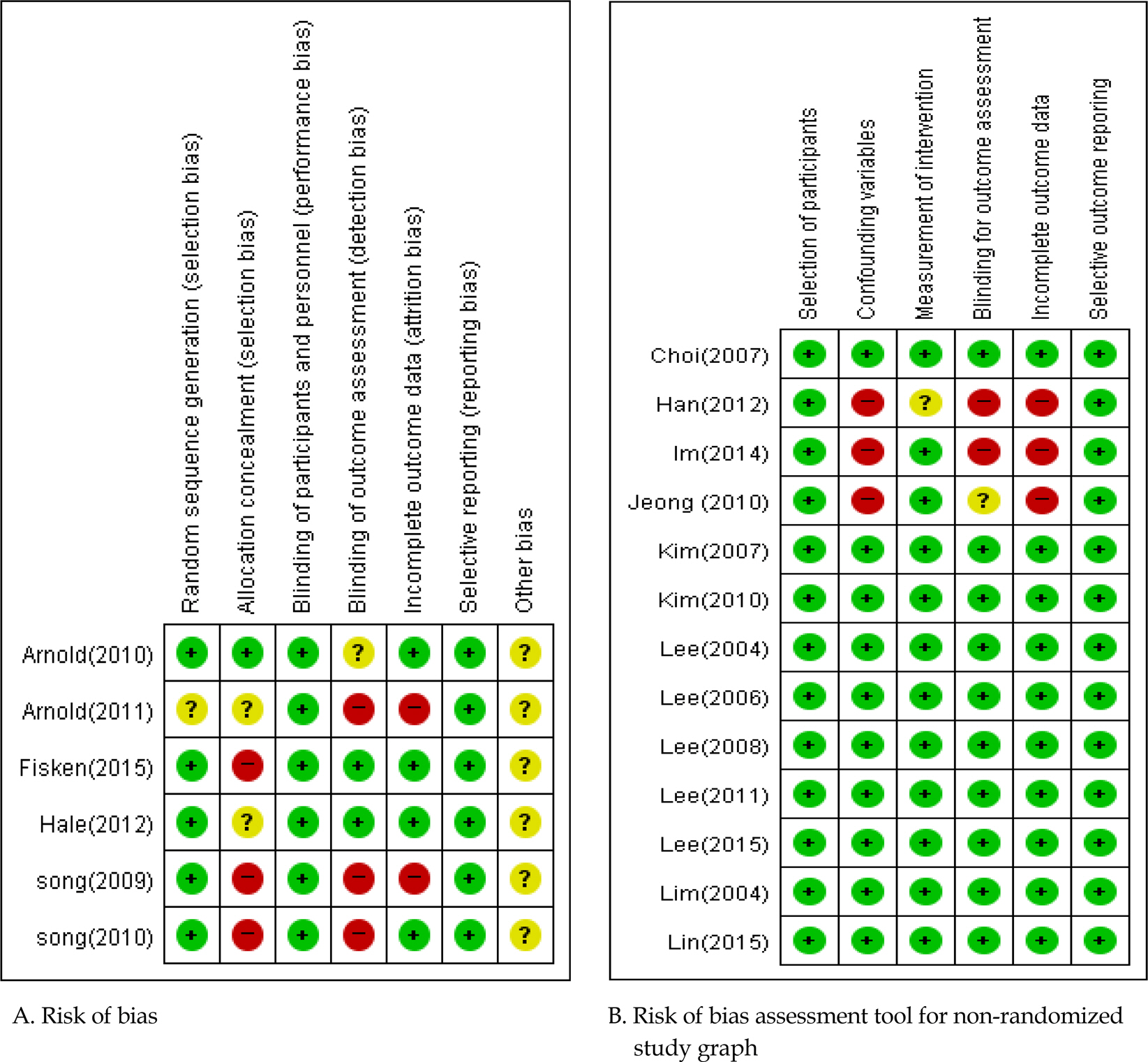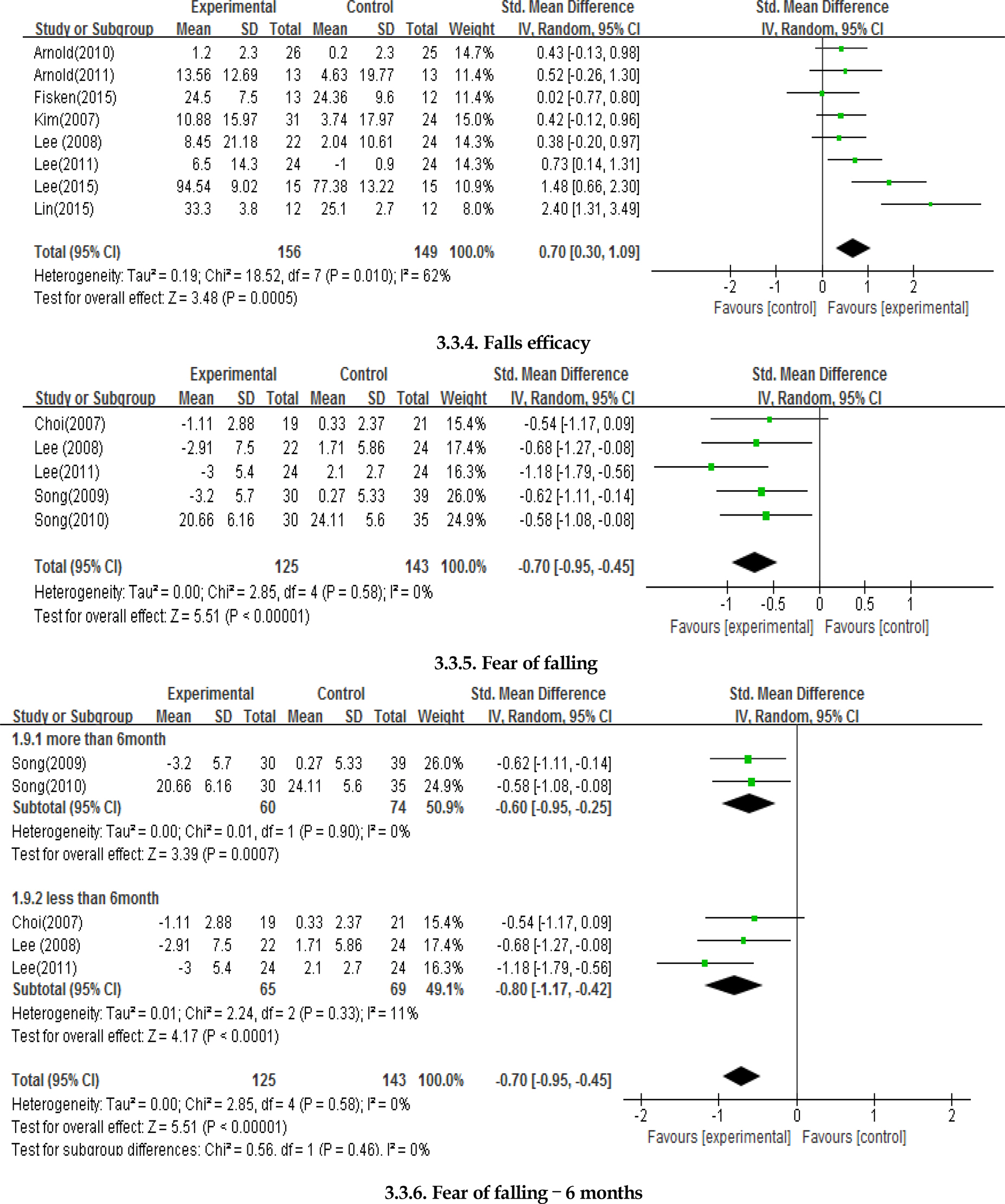1Department of Nursing, Sunlin University, Pohang, Korea
2College of Nursing, Keimyung University, Deagu, Korea
© 2017 Korean Society of Adult Nursing
This is an open access article distributed under the terms of the Creative Commons Attribution Non-Commercial License (http://creativecommons.org/licenses/ by-nc/3.0), which permits unrestricted non-commercial use, distribution, and reproduction in any medium, provided the original work is properly cited.
ABC=activities-specific balance; BBS=berg balance scale; BeHaS=be happy and strong exercise; Cont=control group; Exp=experimental group; FES=falls efficacy scale; FES-I=falls efficacy scale-international; FOFQ=fear of falling questionnaire; MCTSIB=modified clinical test of sensory interaction and balance; N/R=not reported; NRCT=non-randomized controlled trials; RCT=randomized controlled trials; Comm.=Community; Hosp.=Hospital; LE=Lower extremity; MS=Muscle strength; AE=Aquatic exercise; TUG=timed up-and-go test; SAFE=survey of activities and fear of falling in the elderly; 6MWT=6~minute walk test.





Characteristics of Articles Analyzed in the Study
| No | First author (Year) | Location | Study design | Participants | Setting | Intervention (exercise) | Outcome measures | ||||
|---|---|---|---|---|---|---|---|---|---|---|---|
| Exp (n) | Cont (n) | Age (year) | Type | Min/session/ duration (wks) | Physical | Emotional | |||||
| 1 | Fisken (2015) | New Zealand | RCT | 13 | 12 | 71 | Comm. | Aquatic exercise | 45~60/2/12 | TUG 400 m walk test | FES-l |
| 2 | Lin (2015) | Netherland | NRCT | 12 | 12 | 64 | Comm. | Walked on a treadmill | N/R | FES | |
| 3 | Hale (2012) | New Zealand | RCT | 20 | 15 | 74 | Comm. | Aquatic exercise | 20~60/2/12 | TUG | |
| 4 | Arnold (2011) | Canada | RCT | 26 | 27 | 74 | Hosp. | Aquatic exercise | 45/2/11 | BBS TUG 6MWT MCTSIB | ABC |
| 5 | Arnold (2010) | Canada | RCT | 55 | 27 | 74 | Comm. | Aquatic exercise | 45/2/11 | BBS TUG 6MWT | ABC |
| 6 | Song (2010) | South Korea | RCT | 30 | 35 | 62 | Comm. | Tai Chi | 60/1/24 | SAFE | |
| 7 | Lee (2015) | South Korea | NRCT | 15 | 15 | 57 | Comm. | Aquatic exercise | 50/5/8 | Walking speed test Step test (number) TUG | FES |
| 8 | Im (2014) | South Korea | NRCT | 11 | 11 | 64 | Comm. | Aquatic exercise | 60/3/12 | Balance scale (sec) | |
| 9 | Han (2012) | South Korea | NRCT | 10 | 9 | 66 | Comm. | Aquatic exercise | 50/3/12 | Gait speed (sec) | |
| 10 | Lee (2011) | South Korea | NRCT | 24 | 24 | 74 | Comm. | LE MS | 30/2/8 | FES FOFQ | |
| 11 | Jeong (2010) | South Korea | NRCT | 20 | 20 | 62 | Comm. | AE | 120/2/6 | Balance scale (sec) | |
| 12 | Kim (2010) | South Korea | NRCT | 18 | 18 | 54 | Comm. | BeHaS | 65~90/1/12 | Balance scale (sec) - Static balance - TUG Walking ability - Gait speed (sec) - Gait times (sec) | |
| 13 | Song (2009) | South Korea | RCT | 30 | 39 | 61 | Comm. | TaiChi | 60/1/24 | SAFE | |
| 14 | Lee (2008) | South Korea | NRCT | 22 | 24 | 75 | Comm. | TaiChi | 60/2/12 | Balance scale (sec) TUG test | FES FOFQ |
| 15 | Kim (2007) | South Korea | NRCT | 31 | 24 | 70 | Comm. | BeHaS | 65~80/2/8 | Balance scale (sec) | FES |
| 16 | Choi (2007) | South Korea | NRCT | 19 | 21 | 66 | Comm. | TaiChi | 60/1/6 | FOFQ | |
| 17 | Lee (2006) | South Korea | NRCT | 32 | 29 | 50 | Hosp. | TaiChi | 50/1/12 | Balance scale (sec) | |
| 18 | Lee (2004) | South Korea | NRCT | 15 | 13 | 66 | Comm. | TaiChi | 60/1/8 | Balance scale (score) Gait (score) | |
| 19 | Lim (2004) | South Korea | NRCT | 27 | 27 | 49 | Hosp. | TaiChi | 60/3/8 | Balance scale (sec) | |
ABC=activities-specific balance; BBS=berg balance scale; BeHaS=be happy and strong exercise; Cont=control group; Exp=experimental group; FES=falls efficacy scale; FES-I=falls efficacy scale-international; FOFQ=fear of falling questionnaire; MCTSIB=modified clinical test of sensory interaction and balance; N/R=not reported; NRCT=non-randomized controlled trials; RCT=randomized controlled trials; Comm.=Community; Hosp.=Hospital; LE=Lower extremity; MS=Muscle strength; AE=Aquatic exercise; TUG=timed up-and-go test; SAFE=survey of activities and fear of falling in the elderly; 6MWT=6~minute walk test.
Appendix 2. Search Strategies
| PubMed | |
|---|---|
| #1 | Arthritis[MeSH] |
| #2 | Osteo∗ OR Rheumatoid |
| #3 | #1 AND #2 |
| #4 | Fall OR Fall∗ OR Fall∗ prevention |
| #5 | Exercise[MeSH] OR Walking[MeSH] OR Walk∗ OR Muscle Contraction[MeSH] OR Strengthening OR Jogging[MeSH] |
| OR Running[MeSH] OR Run∗ OR Swimming [MeSH] OR Aquatic exercise OR Hydrotherapy[MeSH] OR Tai chi OR Tai ch∗ | |
| #6 | #4 OR #5 |
| #7 | #3 AND #6 |
| Ovid-MEDLINE | |
| 1 | Arthritis |
| 2 | Osteo∗ OR Rheumatoid |
| 3 | 1 AND 2 |
| 4 | Fall OR Fall∗ OR Fall∗ prevention |
| 5 | Exercise OR Walking OR Walk∗ OR Muscle Contraction OR Strengthening OR Jogging OR Running OR Run∗ OR |
| Swimming OR Aquatic exercise OR Hydrotherapy OR Tai chi OR Tai ch∗ | |
| 6 | 4 OR 5 |
| 7 | 3 AND 6 |
| CINAHL | |
| S1 | Arthritis AND (Osteo$ OR Rheumatoid) |
| S2 | Fall OR Fall$ OR Fall∗ prevention |
| S3 | Exercise OR Walking OR Walk∗ OR Muscle Contraction OR Strengthening OR Jogging OR Running OR Run∗ OR |
| Swimming OR Aquatic exercise OR Hydrotherapy OR Tai chi OR Tai ch∗ | |
| S4 | S2 OR S3 |
| S5 | S1 AND S4 |
| EMBASE | |
| 1 | Arthritis[EMTREE] |
| 2 | Osteo$ OR Rheumatoid |
| 3 | 1 AND 2 |
| 4 | Fall OR Fall$ OR Fall∗ prevention |
| 5 | Exercise OR Walking[EMTREE] OR Walk∗ OR Muscle Contraction[EMTREE] OR Strengthening exercise[EMTREE] OR |
| Jogging[EMTREE] OR Running[EMTREE] OR Run∗ OR Swimming[EMTREE] OR Aquatic exercise[EMTREE] OR | |
| Hydrotherapy [EMTREE] OR Tai chi[EMTREE] OR Tai ch∗ | |
| 6 | 4 OR 5 |
| 7 | 3 AND 6 |
ABC=activities-specific balance; BBS=berg balance scale; BeHaS=be happy and strong exercise; Cont=control group; Exp=experimental group; FES=falls efficacy scale; FES-I=falls efficacy scale-international; FOFQ=fear of falling questionnaire; MCTSIB=modified clinical test of sensory interaction and balance; N/R=not reported; NRCT=non-randomized controlled trials; RCT=randomized controlled trials; Comm.=Community; Hosp.=Hospital; LE=Lower extremity; MS=Muscle strength; AE=Aquatic exercise; TUG=timed up-and-go test; SAFE=survey of activities and fear of falling in the elderly; 6MWT=6~minute walk test.